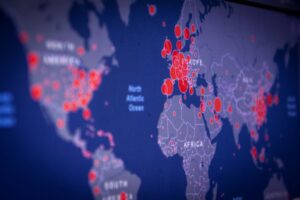 If only we could track COVID-19 like we track the weather, with satellites and weather stations placed around the globe monitoring and sounding the alarm about potential storms, floods, droughts and other severe weather events.
If only we could track COVID-19 like we track the weather, with satellites and weather stations placed around the globe monitoring and sounding the alarm about potential storms, floods, droughts and other severe weather events.
A global pathogen surveillance network would save countless lives, and lessons learned from the current coronavirus pandemic could help make it possible, PacBio Chief Scientific Officer Jonas Korlach told Mendelspod host Theral Timpson (@theraltweet).
Korlach joined Brian Caveney, President and Chief Medical Officer of Labcorp, in a recent podcast to discuss SARS-CoV-2 viral surveillance and the trajectory of COVID research, vaccination and treatment.
PacBio has partnered with the national diagnostic testing company to support its large-scale SARS-CoV-2 testing, which has become part of the US Centers for Disease Control’s COVID19 genomic surveillance effort. Labcorp has sequenced thousands of samples from around the country on its fleet of Sequel II Systems, and worked closely with PacBio to develop a new HiFiViral SARS-CoV-2 Workflow protocol to enable any laboratory to rapidly and efficiently power viral mutation surveillance using PacBio’s HiFi sequencing.
While rapid COVID19 diagnostic testing is generally being done via PCR methods, there is still an important role for viral sequencing, Korlach said. PCR tests provide very limited information about genomic mutations and might not be able to identify which variant of the virus a person is infected with. HiFi sequencing on the PacBio systems can provide a highly detailed profile of the 30,000 base-pair long SARS-CoV-2 virus, including specific mutations and whether there are multiple subtypes of the virus in individual patients, which has been detected.
Labcorp is using both methods, Caveney said. The company has performed more than 38 million COVID-19 PCR tests, and sequenced more than 20,000 genomes with PacBio technology. Not only is the whole-genome sequencing useful in accelerating scientists’ understanding of the virus as it evolves, but it has helped Labcorp ensure its PCR tests continue to be sensitive to emerging variants and mutations.
“Our research and development team loves working with the PacBio equipment. They like the incredible ability to have high specificity with the long reads that we’re getting,” Caveney said. “It’s going to continue to be a very important research tool for both sides of the house — the diagnostic side, as well as the clinical research side — to make sure that the best medications, therapeutics and vaccines are coming to market.”
Another benefit of sequencing technology in the realm of infectious diseases is that it is a “universal measuring device,” Korlach said. Whether the pathogen is a virus or bacterium a DNA sequencer can detect either.
“It’s COVID today and the variants of COVID tomorrow, but what about all the other infectious disease agents that for many decades have cost millions of lives?” Korlach said. “We now have opportunities to tackle them a lot better than we have in the past, using the COVID pandemic as a blueprint.”
Caveney agreed. “We’re so focused on COVID, but 30, 40, 50,000 Americans die every year from influenza. And we now have learning from COVID that might help us bring that number down in the future. That would be a great win, in spite of the tragedy we just went through.”
So what would it take to create a global pan-pathogen surveillance network?
Collaboration, between and among scientific communities, public health agencies, and private companies, Caveney said. An international standardization of nomenclature is also high on his wishlist, “so that regardless of the instruments or the technology used to do the sequencing, it results in information that can be compared and assimilated in a way that all scientists and doctors know what to do with it.”
Continued investment, Korlach said. “Are we willing to keep investing and focusing on making that change permanent and applying it to other infectious diseases, of really building out a permanent and stable network where the routine medical care is going to shift from measuring a temperature and looking in your mouth to getting samples genomically tested within days? That is a future that I think is possible, and that I would like to be part of trying to do our little part to make that happen.”
To learn more about genome surveillance and the benefits of PacBio sequencing, explore our COVID-19 sequencing tools and resources
May 4, 2021 | Public health + surveillance